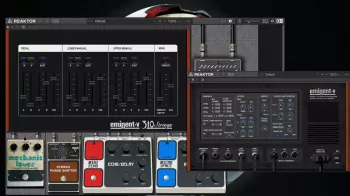Hugo Portillo Eminent-V 310 Strings Ensemble MkII for REAKTOR FREE

REAKTOR | ENS | 24.34 MB
Emulation of the strings ensemble section of the Eminent 310 Unique/Theatre Organ
Browsing an old hard drive (again) I have found a raw mix of Oxygene 6, from way back 2007/2008. I don't even remember what DAW I used. But here it is, as the third demo track. It has just 5 instrument parts, all done with the ensemble, except for the Minipops, which I believe it was a sample loop. Unfortunately, no ARP 2600 seagulls, Synthi/VCS3 seashore effects or RMI Harmonic Synth lead :)
--------
To celebrate Christmas 2016 and the 40th anniversary of the original and groundbreaking Oxygene, after 8 years I finally finished a new and improved version of my classic ensemble.
----------
NEWS December 5, 2018: While going through an old hard drive, I have found the version of the ensemble I originally posted. File date is January 9, 2008, nine days before my daughter was born! :) Since there has been requests from Reaktor 5 users, I have included it into the download package. Please note that this version has a bug in the oscillators where some cables are missing.
Also, check Vladimir Manuylov's improvisation using the ensemble:
Check his other projects too. He makes very good music.
Bug fix November 27, 2017: Pedal register low note priority working properly now. Courtesy of NI's Monark :) Thanks, Brendan, for reporting (and reminding me about) this long overdue bug.
Enjoy!
----------
During these years many string synthesizers have come and gone: String Dreams, Cromina, Strings, Nightflight, VSM, etc. and I have them all. Few are still in my library: Loomer’s Strings, Nightflight (sadly not 64bit), Arturia’s Solina-V, and Jiggery-Pokery’s Combo 310.
Yet, I’m still fond of mine, as it is a labor of love, it looks and sounds good! And this new version is even better as I have learned a lot during these years.
I’m leaving the original description below. Here are the changes:
- New and improved oscillators. I based them on the ones that came with Reaktor 6.
- New more modern interface colors.
- The ensemble now responds to the pitch wheel with a maximum range -/+24 semitones. NOTE: As this is an emulation of a divide-down circuitry where all registers and manuals share only one oscillator per note, the pitch bend affect all registers and manuals at the same time (Pedal, Lower and Upper)
- Master tuning knob added just in case. When trying to play along early Tangerine Dream records I became aware of its necessity! :-)
- Better filters from NI’s Core library.
- Dry/Wet mix knob added to the Chorus Unit.
- Chorus unit can have 2, 3 (default) and 4 delay lines.
- Better effects: I have modified the echo/delay unit to be true stereo and with less distortion. Still based on Michats Space Echo.
- Added a modified emulation inspired on the EHX Electric Mistress courtesy of ZooTook.
- Now you have the option of using three models of phase shifters: a) NI’s emulation of the EHX Small Stone b) Modified ZooTook’s versions inspired on the MXR Phase 100 and Phase 90. Select then using the three dots in the upper right side of the effect panel.
- Added a manual switch on the phase shifters. When it is engaged you can control the phase sweep manually with the Speed/Rate knob. Attach it to the modulation wheel for instant gratification!
I left the old audio demo in the page and added a new not too good one :-)
Again, my great thanks to Native Instruments, ZooTook, Mark Smart, Radek Tymecki, Jürgen Haible (sadly, he passed away in 2011), Michael Wöstefeld, Hertz SM, g200kg, HunterKiller from the KVR forums, and all of you for your comments.
NOTE: The downloadable package contains in addition to the new version 2.1 of the ensemble, the original 1.1 version, which I fixed as it contained a bug (forgot to connect one cable) that made the oscillators alias at high frequencies.
The below is the original description left for historical purposes:
After I finished my Solina emulation I was pretty much satisfied with this string ensemble emulation thing. But on May 2007 I read this article: http://www.soundonsound.com/sos/may07/articles/eminent310.htm
Then an idea started to build in my mind: create an emulation of this mighty machine, the Eminent 310 organ. At first my goal was to recreate the whole organ, but after months and months of experiments, research, and trial and error I set a more modest goal: to emulate just the strings ensemble section of it.
Now, after 8 months of work here it is. It has some improvements over my Solina-V: better oscillators and an improved chorus unit.
Description:
Basically this instrument emulates the upper and lower manuals of the strings ensemble section. Also, it adds a pedal section for monophonic bass lines. This is based on the Solina SE not on the 310. Each section has a keyboard split, independent MIDI channel and transpose up to +-3 octaves. Another difference is that I created envelope controls for each string registers to further tweak the sound. If you want a truly 310 behavior leave the envelope sliders at their default values.
The effects section has the standard macros from the library with a different face (Graphic 10 EQ, Micro Space, and Kleinstein Phaser), except the delay which is a cut down version of Michael Wöstefeld’s Michats Space Echo ME-201.
Use the A/B views to switch to the back panel controls to further tweak the sound.
WARNING: With all the effects and manuals on you with get a high CPU usage (+60% on a Pentium D 3.0 GHz)
I made a lame demo going thru most of the presets, everything played live, except Oxygene 6 which is sequenced; therefore, please forgive my lousy playing :-)
If you ever tried to get that “Jarre sound” with this you can get very close.
